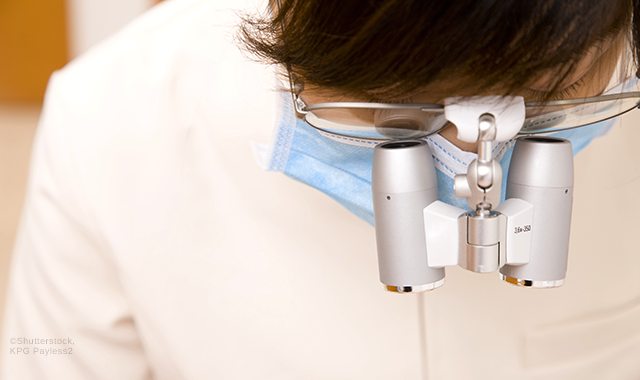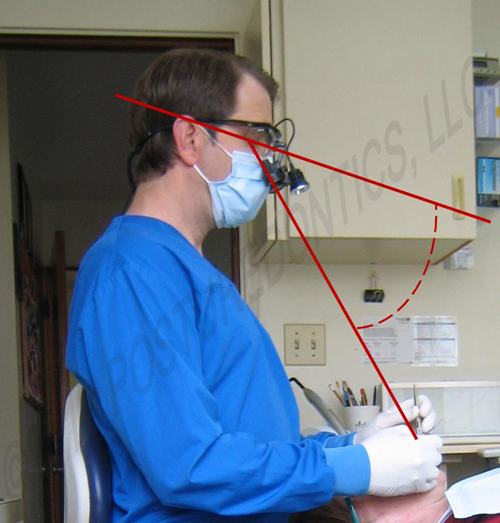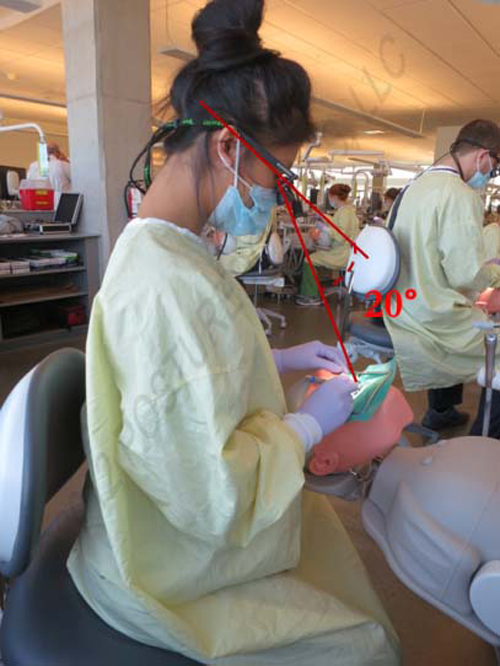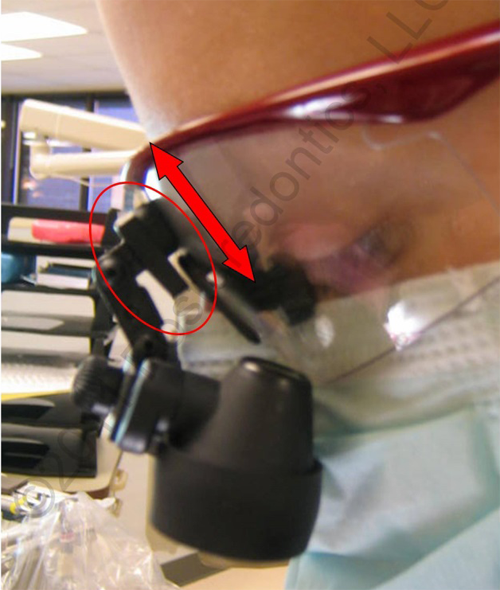Are dental loupes improving or worsening your neck health?
Selecting the correct loupes can make a big difference for your health.

Imagine spending $1,500 on new loupes, and you suddenly begin to develop neck pain, or, your existing neck pain worsens. This is an all-too-common problem that I frequently encounter in my dental ergonomic consultations.
On the other hand, I have repeatedly seen well-designed ergonomic loupes improve or completely resolve neck pain. So how do you know if your loupes are improving or worsening your health?
Fig. 1

Of all the criteria for selecting loupes (working distance, frame size, scope position, declination angle, co-axial adjustment), declination angle is the most important ergonomic factor that can make or break your health.
Consider that working with the neck flexed forward only 20 degrees or more for 70 percent of the working time has been associated with neck pain. While no loupe systems provide completely neutral head posture (ear-over-shoulder), loupes with a steep declination angle may significantly improve operator working postures in dentistry, thereby lessening risk of musculoskeletal disorders and improving clinician comfort. Therefore, to prevent musculoskeletal injury, loupes should enable you to work with less than 20 degrees of forward head posture.
More from the author: 3 ergonomic mistakes that could end your dental career
Declination angle
The angle that your eyes are inclined downward toward the work area is the declination angle. (Fig. 1) This angle should be steep enough to help you attain a comfortable working position with minimal forward head posture. To stay within this safe head posture requires a loupe with a steep declination-from 40 to 50 degrees. Vertically adjustable flip-up loupes are the only option on the market that I have seen that consistently keep operators within this safe head posture.
Many team members opt for through-the-lens loupes, which typically cannot achieve greater than a 30-degree declination angle, and very often force the operator into unsafe forward head postures. Among my dental students, I have repeatedly measured the declination angle of TTL loupes that were promised to have a declination angle of 40-45 degrees, only to discover they had only a 20-25 degree declination angle. (Figs. 2-3)


FIg. 2 Fig. 3
More on ergonomics: Why all exercise is not necessarily good exercise for dentists
Continue to page two to learn about the pros and cons of flip-up loupes...
In the past, many female dentists and hygienists have steered clear of flip-up loupes due to the heavier weight. With the new ultra-light weight flip-ups on the market today, weight is a no longer an issue. Sales reps often dissuade customers from purchasing flip-up loupes, saying they can come out of adjustment. Yes, if you sit on them or run over them with you chair, you may need to readjust them. However, if you follow the manufacturer’s guidelines for adjustment and securely tighten the hinges with the enclosed wrench, they should stay adjusted for quite some time.
More from the author: Demystifying pain among women in dentistry
When assessing flip-up loupes, keep in mind that scope position is critical. You can have loupes with the best declination angle on the market, but if they sit high in relation to your pupil, you will lose much of the ergonomic benefit, since you must lean further forward to look through the scopes. There are several non-ergonomic flip-up loupes on the market are not vertically adjustable, which will cause the same poor postures as seen with most TTL loupes.
Fig. 4

Therefore, vertical adjustability is an essential feature on flip-up loupes. Companies achieve this with a vertical slide mechanism (Fig. 4), an ‘extender’ or a ball-and-socket system. All of these vertical adjustability systems greatly improve declination angle and head posture. At the time of this writing, there are only four loupes manufacturers that make vertically adjustable loupes.
Related ergonomics reading: Hand pain in the dental practice: When it's not carpal tunnel
To further improve your declination angle, make sure your flip-up scope is mounted on frames with a pantoscopic tilt feature. A pantoscopic tilt feature angles the bottom of the lenses toward the cheek which allows a steeper downward of the scope.
October is Ergonomics Month! Loupes are an expensive investment that should last you many, many years. Take the time, do the research and find a loupe that will improve your health … not make it worse!
For a free list of manufacturers and models of vertically adjustable flip-up loupes that meet the author’s ergonomic criteria, please e-mail info@posturedontics.com.
Oral Health Pavilion at HLTH 2024 Highlighted Links Between Dental and General Health
November 4th 2024At HLTH 2024, CareQuest, Colgate-Palmolive, Henry Schein, and PDS Health launched an Oral Health Pavilion to showcase how integrating oral and general health can improve patient outcomes and reduce costs.
Episode 31: Dentsply Sirona Implant Announcements
September 30th 2021DPR’s Editorial Director Noah Levine sat down with Gene Dorff, Dentsply Sirona’s group vice president of implants and Dr. Dan Butterman to review several big announcements the company made in the arena of implants during Dentsply Sirona World 2021 in Las Vegas.